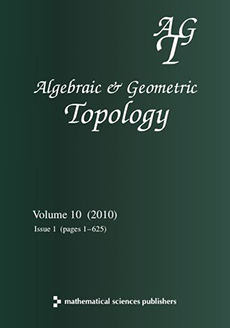Abstract
We show that if is an indecomposable –complex and is the fundamental group of a reduced finite graph of finite groups but is neither nor then is orientable, the underlying graph is a tree, the vertex groups have cohomological period dividing 4 and all but at most one of the edge groups is . If there are no exceptions then all but at most one of the vertex groups is dihedral of order with odd. Every such group is realized by some –complex. Otherwise, one edge group may be . We do not know of any such examples.
We also ask whether every –complex has a finite covering space which is homotopy equivalent to a closed orientable 3-manifold, and we propose a strategy for tackling this question.
Citation
Jonathan A Hillman. "Indecomposable $\mathrm{PD}_3$–complexes." Algebr. Geom. Topol. 12 (1) 131 - 153, 2012. https://doi.org/10.2140/agt.2012.12.131
Information





